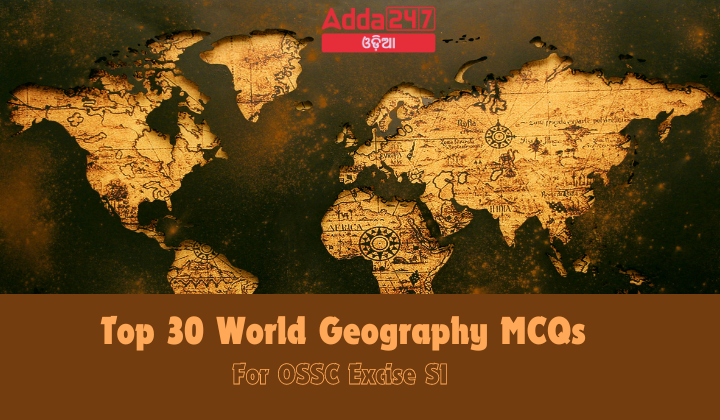Preparing for the OSSC Excise Sub-Inspector exam requires a thorough understanding of various subjects, including world geography. To assist you in your preparation, here are 30 multiple-choice questions (MCQs) covering diverse aspects of world geography. These questions are designed to test your knowledge and enhance your understanding of global geographical phenomena.
Top 30 World Geography MCQs For OSSC Excise SI
- ‘The Land of the Morning Calm’ is
A. Japan
B. Malaysia
C. Indonesia
D. Korea
Answer: D. Korea
Discussion:
Korea is historically known as “The Land of the Morning Calm” due to its serene natural landscapes and tranquil morning environments. This name was given by the Chinese, reflecting Korea’s peaceful and picturesque nature. - Dogger Bank, Rockall Bank, Wales Bank, and Sand Bank are located in
A. North West Atlantic
B. North East Pacific
C. North East Atlantic
D. North West Pacific
Answer: C. North East Atlantic
Discussion:
These banks are submarine elevations in the North East Atlantic. Dogger Bank, for instance, is located in the North Sea and is known for its rich fishing grounds. - Mid-latitude or temperate forests include the trees of
A. Rosewood, Mahogany, Rubber
B. Teak, Sal, Bamboo
C. Pine, Fir, Spruce
D. Olive, Maple, Walnut
Answer: D. Olive, Maple, Walnut
Discussion:
Mid-latitude or temperate forests feature a variety of tree species, including olive, maple, and walnut, which thrive in the moderate climates typical of these regions. - White coal refers to
A. Hydroelectricity
B. Petroleum
C. Uranium
D. Coal
Answer: A. Hydroelectricity
Discussion:
White coal is a term used to describe hydroelectricity because of its clean and renewable nature, in contrast to fossil fuels like coal. - Ladang refers to
A. Shifting cultivation
B. Plantation agriculture
C. Subsistence type of agriculture
D. Dry farming
Answer: A. Shifting cultivation
Discussion:
Ladang is a term used in Southeast Asia to describe shifting cultivation, a traditional farming method where land is cleared, farmed for a few years, and then abandoned for a new area. - The countries with the lowest and worst economic conditions in the world referred to as the ‘Pole of hunger’ are
A. European Countries
B. Middle East Countries
C. Mid-West Countries
D. South East Asian Countries
Answer: A. European Countries
Discussion:
This statement is incorrect and misleading. The term “Pole of hunger” is not commonly used in geographic or economic contexts. Typically, the regions with severe hunger issues are parts of Sub-Saharan Africa, South Asia, and other developing regions, not European countries. - The countries which are called the ‘Rice Bowl’ of Asia are
A. China, Japan, Sri Lanka, India
B. Myanmar, Thailand, Cambodia, and Vietnam
C. India, Pakistan, Nepal, Mongolia
D. Japan, Indonesia, Malaysia, India
Answer: B. Myanmar, Thailand, Cambodia, and Vietnam
Discussion:
These countries are referred to as the ‘Rice Bowl’ of Asia due to their significant rice production, which is a staple food and major agricultural export. - The metallic minerals are
A. Asbestos, mica, graphite
B. Iron ore, copper, lead
C. Coal, oil, natural gas
D. Salt, potash, sulphur
Answer: B. Iron ore, copper, lead
Discussion:
Metallic minerals include iron ore, copper, and lead, which are crucial for industrial applications and construction. - Power minerals are
A. Manganese, platinum, tungsten
B. Mica, potash, sulphur
C. Coal, oil, natural gas
D. Lead, zinc, bauxite
Answer: C. Coal, oil, natural gas
Discussion:
Power minerals, also known as energy minerals, include coal, oil, and natural gas, which are essential for energy production. - Iron ore mining in the former Soviet Union is in
A. Kiruna
B. Mesabi and Gogebic
C. Krivoi Rog and Kerch basin
D. Lorraine field
Answer: C. Krivoi Rog and Kerch basin
Discussion:
Krivoi Rog and the Kerch basin were major iron ore mining regions in the former Soviet Union, contributing significantly to the country’s iron and steel industry. - Mackerel, tuna, herrings, and anchovies belong to _____ type of fish.
A. Pelagic
B. Demersal
C. Anadromous
D. Freshwater
Answer: A. Pelagic - Cod, haddock, halibut, sole, garoupa, and snapper are:
A. Major species of Tropical Forests
B. Cattle breeds
C. Fish varieties
D. Pacific Islands
Answer: C. Fish varieties - Danube, Dneiper, Don, Volga, and Ural rivers flow in:
A. North America
B. Europe
C. Africa
D. Australia
Answer: B. Europe - The Cuban economy is based on:
A. Fishing
B. Sugarcane cultivation
C. Iron ore mining
D. Dairying
Answer: B. Sugarcane cultivation - Hemp of Mesta, Ramie, and Kapok are:
A. Food crops
B. Fodder crops
C. Fibre crops
D. Plantation crops
Answer: C. Fibre crops - Muscovite, Phlogopite, and Biotite are:
A. Iron ore varieties
B. Mica varieties
C. Coal varieties
D. Manganese varieties
Answer: B. Mica varieties - The tropical rainforests in the Amazon basin are known as:
A. Savanna
B. Prairies
C. Selvas
D. Pampas
Answer: C. Selvas - Botswana was formerly known as:
A. Bachuanaland
B. Bahamas
C. Barbados
D. Cameroon
Answer: A. Bachuanaland - Which of the following is the smallest in terms of area?
A. Vatican City
B. Monaco
C. Nauru
D. San Marino
Answer: A. Vatican City - Shifting agriculture is most commonly practiced in:
A. Forests
B. Deserts
C. Plain areas
D. Grasslands
Answer: A. Forests - Consider the following statements about the ‘Roaring Forties’:
- They blow uninterrupted in the Northern and Southern Hemispheres
- They blow with great strength and constancy
- Their direction is generally from North-West to East in the Southern Hemisphere
- Overcast skies, rain and raw weather are generally associated with them
Which of these statements are correct?
A. 1, 2 and 3
B. 2, 3 and 4
C. 1, 3 and 4
D. 1, 2 and 4
Answer: B. 2, 3 and 4
Discussion: The Roaring Forties are strong westerly winds found in the Southern Hemisphere, generally between the latitudes of 40 and 50 degrees. They are known for their consistency and strength, typically blowing from the northwest to the east and are associated with overcast skies and rough weather.
- The correct sequence of different layers of the atmosphere from the surface of the Earth upwards is:
A. Troposphere, Stratosphere, Ionosphere, Mesosphere
B. Stratosphere, Troposphere, Ionosphere, Mesosphere
C. Troposphere, Stratosphere, Mesosphere, Ionosphere
D. Stratosphere, Troposphere, Mesosphere, Ionosphere
Answer: C. Troposphere, Stratosphere, Mesosphere, Ionosphere
Discussion: The Earth’s atmosphere is divided into layers based on temperature gradients. The correct order from the surface upwards is Troposphere, Stratosphere, Mesosphere, and Ionosphere. - _____ canal lies on one of the world’s largest of trade routes connecting Europe and Far East.
A. The Panama
B. The Suez
C. The Kiel
D. The Goth
Answer: B. The Suez
Discussion: The Suez Canal is a crucial waterway in Egypt, connecting the Mediterranean Sea to the Red Sea, facilitating trade between Europe and the Far East. - The Earth’s population has _____ since the turn of the century.
A. stayed the same
B. doubled
C. trebled
D. multiplied ten times
Answer: C. trebled
Discussion: Since the beginning of the 20th century, the global population has approximately trebled, reflecting significant growth due to improvements in medicine, agriculture, and technology. - In which country will you find the river Po?
A. China
B. Italy
C. Sri Lanka
D. Zambia
Answer: B. Italy
Discussion: The Po River is the longest river in Italy, flowing eastward across the northern part of the country. - Uranus takes _____ years to orbit the Sun.
A. 48
B. 84
C. 50
D. 60
Answer: B. 84
Discussion: Uranus takes approximately 84 Earth years to complete one orbit around the Sun. - _____ grasses are known as elephant grasses.
A. Prairie
B. Steppe
C. Savannah
D. Llanos
Answer: C. Savannah
Discussion: Elephant grass is a tall grass species found primarily in tropical and subtropical savannas. - The ‘land of eternal spring’ are certain parts of:
A. Tundra region
B. Highland region
C. Mediterranean region
D. Hot Wet Equatorial region
Answer: D. Hot Wet Equatorial region
Discussion: Regions with a hot wet equatorial climate are often referred to as the “land of eternal spring” due to their consistent warm temperatures and frequent rainfall year-round. - Kolkhoz and Sovkhoz are:
A. farming organization on agriculture
B. fertile alluvial lands
C. high yielding variety seeds
D. breeds of cattle
Answer: A. farming organization on agriculture
Discussion: Kolkhoz and Sovkhoz were collective and state farms, respectively, in the former Soviet Union, focusing on large-scale agricultural production. - Agriculture Involving both crops and livestock is known as:
A. dairy farming
B. mixed farming
C. dry farming
D. truck farming
Answer: B. mixed farming
Discussion: Mixed farming is an agricultural system that combines the cultivation of crops and the raising of livestock, promoting a diversified and sustainable approach to farming.










